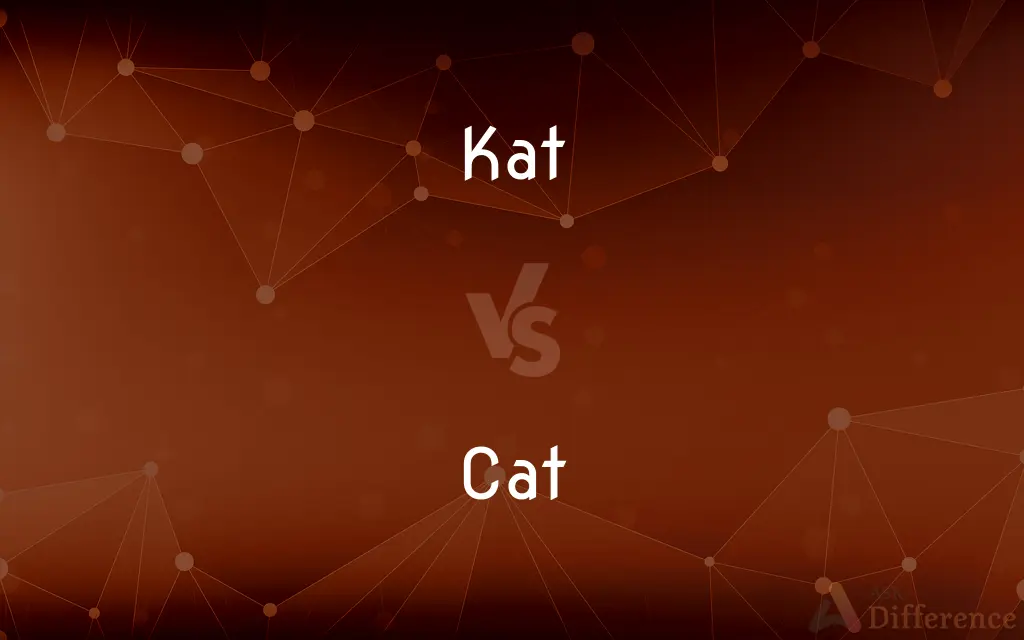Kat vs. Cat — What's the Difference?
By Tayyaba Rehman & Maham Liaqat — Updated on March 17, 2024
Kat refers to a plant with stimulant properties, whereas a cat is a small, domesticated carnivorous mammal.

Difference Between Kat and Cat
Table of Contents
ADVERTISEMENT
Key Differences
Kat, commonly spelled as "khat" in many regions, is a plant known scientifically as Catha edulis. On the other hand, a cat, specifically the domestic cat (Felis catus), is a popular pet worldwide, valued for its companionship and ability to hunt vermin.
Kat contains stimulant compounds like cathinone and cathine, which affect the central nervous system. Cats have been associated with humans for thousands of years and are celebrated for their agility, grace, and independent nature.
People in some cultures chew kat leaves for their mild stimulant effects, which can improve alertness and reduce fatigue. Cats come in a variety of breeds, sizes, and colors, and have a range of personalities from affectionate to more reserved.
The use of kat is deeply embedded in the social and cultural practices of certain East African and Arabian Peninsula communities. Cats are valued for its companionship and ability to hunt vermin.
Comparison Chart
Definition
A plant with stimulant properties.
A small, domesticated carnivorous mammal.
ADVERTISEMENT
Scientific Name
Catha edulis
Felis catus
Use
Chewing leaves for stimulant effects.
Companionship and vermin control.
Origin
East Africa, Arabian Peninsula.
Worldwide, with domestication thousands of years ago.
Cultural Significance
Used in social and cultural practices.
Domestic pet with varied roles in human society.
Compare with Definitions
Kat
Contains compounds cathinone and cathine.
The stimulant effects of kat are due to cathinone.
Cat
Hunts vermin, aiding in pest control.
Farm cats are valued for keeping the barn free of mice.
Kat
Used culturally in East Africa and the Arabian Peninsula.
Kat chewing is a traditional social activity in Yemen.
Cat
Exhibits varied personalities and appearances.
Siamese cats are known for their vocal and affectionate nature.
Kat
Improves alertness and reduces fatigue.
Workers chew kat to stay alert during night shifts.
Cat
Adaptable to various environments.
Cats can thrive in urban, suburban, or rural settings.
Kat
A stimulant plant known as Catha edulis.
Kat leaves were chewed for energy during long work hours.
Cat
A domesticated mammal, Felis catus, known for companionship.
The cat curled up in her lap, purring contentedly.
Kat
Integrated into social ceremonies.
Kat is often consumed in gatherings and celebrations.
Cat
Has been a human companion for millennia.
Ancient Egyptians revered cats, associating them with gods.
Kat
An Arabian shrub (Catha edulis) the leaves of which are used as tea by the Arabs.
Cat
The cat (Felis catus) is a domestic species of small carnivorous mammal. It is the only domesticated species in the family Felidae and is often referred to as the domestic cat to distinguish it from the wild members of the family.
Cat
A small domesticated carnivorous mammal (Felis catus), kept as a pet and as catcher of vermin, and existing in a variety of breeds.
Cat
Any of various other carnivorous mammals of the family Felidae, including the lion, tiger, leopard, and lynx.
Cat
(Informal) A woman who is regarded as spiteful.
Cat
A person, especially a man.
Cat
A player or devotee of jazz music.
Cat
A cat-o'-nine-tails.
Cat
A catfish.
Cat
A cathead.
Cat
A device for raising an anchor to the cathead.
Cat
A catboat.
Cat
A catamaran.
Cat
To hoist an anchor to (the cathead).
Cat
An animal of the family Felidae:
Cat
A domesticated species (Felis catus) of feline animal, commonly kept as a house pet.
Cat
Any similar animal of the family Felidae, which includes lions, tigers, bobcats, leopards, cougars, cheetahs, caracals, lynxes, and other such non-domesticated species.
Cat
A person:
Cat
(offensive) A spiteful or angry woman.
Cat
An enthusiast or player of jazz.
Cat
(slang) A person (usually male).
Cat
(slang) A prostitute.
Cat
(nautical) A strong tackle used to hoist an anchor to the cathead of a ship.
Cat
Short form of cat-o'-nine-tails.
Cat
(archaic) A sturdy merchant sailing vessel now only in "catboat".
Cat
The game of "trap and ball" (also called "cat and dog").
Cat
The trap of the game of "trap and ball".
Cat
(archaic) The pointed piece of wood that is struck in the game of tipcat.
Cat
A double tripod (for holding a plate, etc.) with six feet, of which three rest on the ground, in whatever position it is placed.
Cat
(historical) A wheeled shelter, used in the Middle Ages as a siege weapon to allow assailants to approach enemy defences.
Cat
(computing) A program and command in Unix that reads one or more files and directs their content to the standard output.
Cat
(slang) A street name of the drug methcathinone.
Cat
Abbreviation of catapult
A carrier's bow cats
Cat
Abbreviation of catalytic converter
Cat
Abbreviation of catamaran
Cat
Abbreviation of category
Cat
Abbreviation of catfish
Cat
Abbreviation of caterpillar
Cat
(slang) Any of a variety of earth-moving machines. (from their manufacturer Caterpillar Inc.)
Cat
A ground vehicle which uses caterpillar tracks, especially tractors, trucks, minibuses, and snow groomers.
Cat
Abbreviation of computed axial tomographyOften used attributively, as in “CAT scan” or “CT scan”.
Cat
To hoist (the anchor) by its ring so that it hangs at the cathead.
Cat
To flog with a cat-o'-nine-tails.
Cat
(slang) To vomit.
Cat
To go wandering at night.
Cat
To gossip in a catty manner.
Cat
To apply the cat command to (one or more files).
Cat
To dump large amounts of data on (an unprepared target), usually with no intention of browsing it carefully.
Cat
Catastrophic; terrible, disastrous.
The weather was cat, so they returned home early.
Cat
Any animal belonging to the natural family Felidae, and in particular to the various species of the genera Felis, Panthera, and Lynx. The domestic cat is Felis domestica. The European wild cat (Felis catus) is much larger than the domestic cat. In the United States the name wild cat is commonly applied to the bay lynx (Lynx rufus). The larger felines, such as the lion, tiger, leopard, and cougar, are often referred to as cats, and sometimes as big cats. See Wild cat, and Tiger cat.
Laying aside their often rancorous debate over how best to preserve the Florida panther, state and federal wildlife officials, environmentalists, and independent scientists endorsed the proposal, and in 1995 the eight cats [female Texas cougars] were brought from Texas and released. . . . Uprooted from the arid hills of West Texas, three of the imports have died, but the remaining five adapted to swamp life and have each given birth to at least one litter of kittens.
Cat
A strong vessel with a narrow stern, projecting quarters, and deep waist. It is employed in the coal and timber trade.
Cat
A double tripod (for holding a plate, etc.), having six feet, of which three rest on the ground, in whatever position it is placed.
Cat
An old game;
Cat
Same as cat o' nine tails; as, British sailors feared the cat.
Cat
A catamaran.
Cat
To bring to the cathead; as, to cat an anchor. See Anchor.
Cat
Feline mammal usually having thick soft fur and being unable to roar; domestic cats; wildcats
Cat
An informal term for a youth or man;
A nice guy
The guy's only doing it for some doll
Cat
A spiteful woman gossip;
What a cat she is!
Cat
A whip with nine knotted cords;
British sailors feared the cat
Cat
A large vehicle that is driven by caterpillar tracks; frequently used for moving earth in construction and farm work
Cat
Any of several large cats typically able to roar and living in the wild
Cat
A method of examining body organs by scanning them with X rays and using a computer to construct a series of cross-sectional scans along a single axis
Cat
Beat with a cat-o'-nine-tails
Cat
Eject the contents of the stomach through the mouth;
After drinking too much, the students vomited
He purged continuously
The patient regurgitated the food we gave him last night
Common Curiosities
Do all cultures use kat in social ceremonies?
The use of kat in social ceremonies is specific to certain East African and Arabian cultures, not a worldwide practice.
What is the primary difference between kat and a cat?
Kat is a stimulant plant, while a cat is a domesticated animal.
Are cats found in the same regions as kat?
Cats are found worldwide, including regions where kat is grown, but they are not limited to those areas.
Is there any relationship between kat and cats besides the similarity in names?
There is no direct relationship between kat and cats aside from the phonetic similarity of their names in English.
How do the effects of kat compare to those of caffeine?
Kat's effects are generally considered to be stimulant, similar to but distinct from caffeine, with a more pronounced impact on alertness and mood.
Has the use of kat faced any controversy?
Yes, the use of kat has been controversial, particularly regarding its health effects and legal status in various countries.
Why do some people keep cats as pets?
People keep cats as pets for companionship, their aesthetic appeal, and their natural pest control abilities.
How do people typically consume kat?
People usually chew fresh kat leaves to release their stimulant compounds.
Can the cultivation of kat impact local ecosystems?
The cultivation of kat can impact local ecosystems, especially if it leads to deforestation or the use of harmful agricultural practices.
Can kat be used as a pet?
No, kat is a plant and not an animal; it cannot be kept as a pet.
Is chewing kat legal everywhere?
The legality of kat varies by country, with some places banning its use due to its stimulant properties.
Can cats eat kat leaves?
Feeding kat leaves to cats is not advisable due to potential toxic effects and the difference in metabolism between humans and animals.
What are the key characteristics of a domestic cat?
Domestic cats are known for their agility, independent nature, and roles as companions and pest controllers.
Are there efforts to regulate the cultivation and sale of kat?
Yes, there are efforts in some countries to regulate the cultivation and sale of kat, focusing on its health implications and social effects.
How do cats contribute to human well-being?
Cats contribute to human well-being by providing companionship, reducing stress, and bringing joy to their owners.
Share Your Discovery

Previous Comparison
Accept vs. Except
Next Comparison
Organize vs. CoordinateAuthor Spotlight
Written by
Tayyaba RehmanTayyaba Rehman is a distinguished writer, currently serving as a primary contributor to askdifference.com. As a researcher in semantics and etymology, Tayyaba's passion for the complexity of languages and their distinctions has found a perfect home on the platform. Tayyaba delves into the intricacies of language, distinguishing between commonly confused words and phrases, thereby providing clarity for readers worldwide.
Co-written by
Maham Liaqat















































